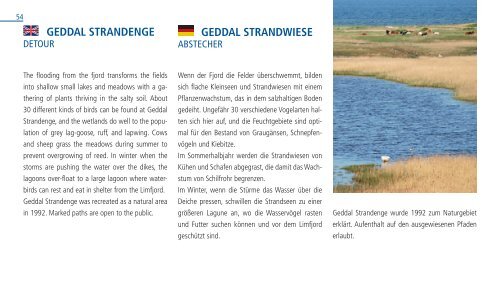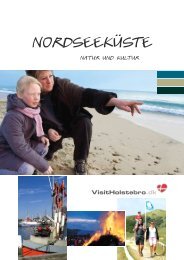Klosterruten
Klosterruten
Klosterruten
Create successful ePaper yourself
Turn your PDF publications into a flip-book with our unique Google optimized e-Paper software.
54<br />
GEDDAL STRANDENGE<br />
DETOUR<br />
The fl ooding from the fjord transforms the fi elds<br />
into shallow small lakes and meadows with a gathering<br />
of plants thriving in the salty soil. About<br />
30 different kinds of birds can be found at Geddal<br />
Strandenge, and the wetlands do well to the population<br />
of grey lag-goose, ruff, and lapwing. Cows<br />
and sheep grass the meadows during summer to<br />
prevent overgrowing of reed. In winter when the<br />
storms are pushing the water over the dikes, the<br />
lagoons over-fl oat to a large lagoon where waterbirds<br />
can rest and eat in shelter from the Limfjord.<br />
Geddal Strandenge was recreated as a natural area<br />
in 1992. Marked paths are open to the public.<br />
GEDDAL STRANDWIESE<br />
ABSTECHER<br />
Wenn der Fjord die Felder überschwemmt, bilden<br />
sich fl ache Kleinseen und Strandwiesen mit einem<br />
Pfl anzenwachstum, das in dem salzhaltigen Boden<br />
gedeiht. Ungefähr 30 verschiedene Vogelarten halten<br />
sich hier auf, und die Feuchtgebiete sind optimal<br />
für den Bestand von Graugänsen, Schnepfenvögeln<br />
und Kiebitze.<br />
Im Sommerhalbjahr werden die Strandwiesen von<br />
Kühen und Schafen abgegrast, die damit das Wachstum<br />
von Schilfrohr begrenzen.<br />
Im Winter, wenn die Stürme das Wasser über die<br />
Deiche pressen, schwillen die Strandseen zu einer<br />
größeren Lagune an, wo die Wasservögel rasten<br />
und Futter suchen können und vor dem Limfjord<br />
geschützt sind.<br />
Geddal Strandenge wurde 1992 zum Naturgebiet<br />
erklärt. Aufenthalt auf den ausgewiesenen Pfaden<br />
erlaubt.




